Noise: From nuisance to research subject
DOI: 10.1063/PT.3.4409
Noise is associated with various phenomena, ranging from unwanted sounds to random fluctuations in thermodynamic systems. Beyond it being an acoustic property, scientists now regard noise as a limiting factor in information theory and measurement processes. How have so many meanings arisen? The history of noise over the past 150 years shows that its definition has undergone a series of semantic and conceptual shifts and extensions.
One of the most fascinating topics in science is the development of the various, sometimes even contradictory, meanings and concepts of noise. Yet not much has been written about its history. That might be because researchers often view noise negatively, and associate it with what to get rid of, such as distortions in data that need to be eliminated, suppressed, or filtered. But not all definitions amount to what is unwanted. Noise is a factor, if not the focus of scientific concern, in the more complex scenario between disturbance and signal. To understand the multiple meanings and definitions, researchers must understand the different contexts in which they emerged.

Luigi Russolo, an early 20th-century Italian futurist, embraced noise in his paintings, including this one, La Musica, from 1911. (The History Collection/Alamy Stock Photo.)
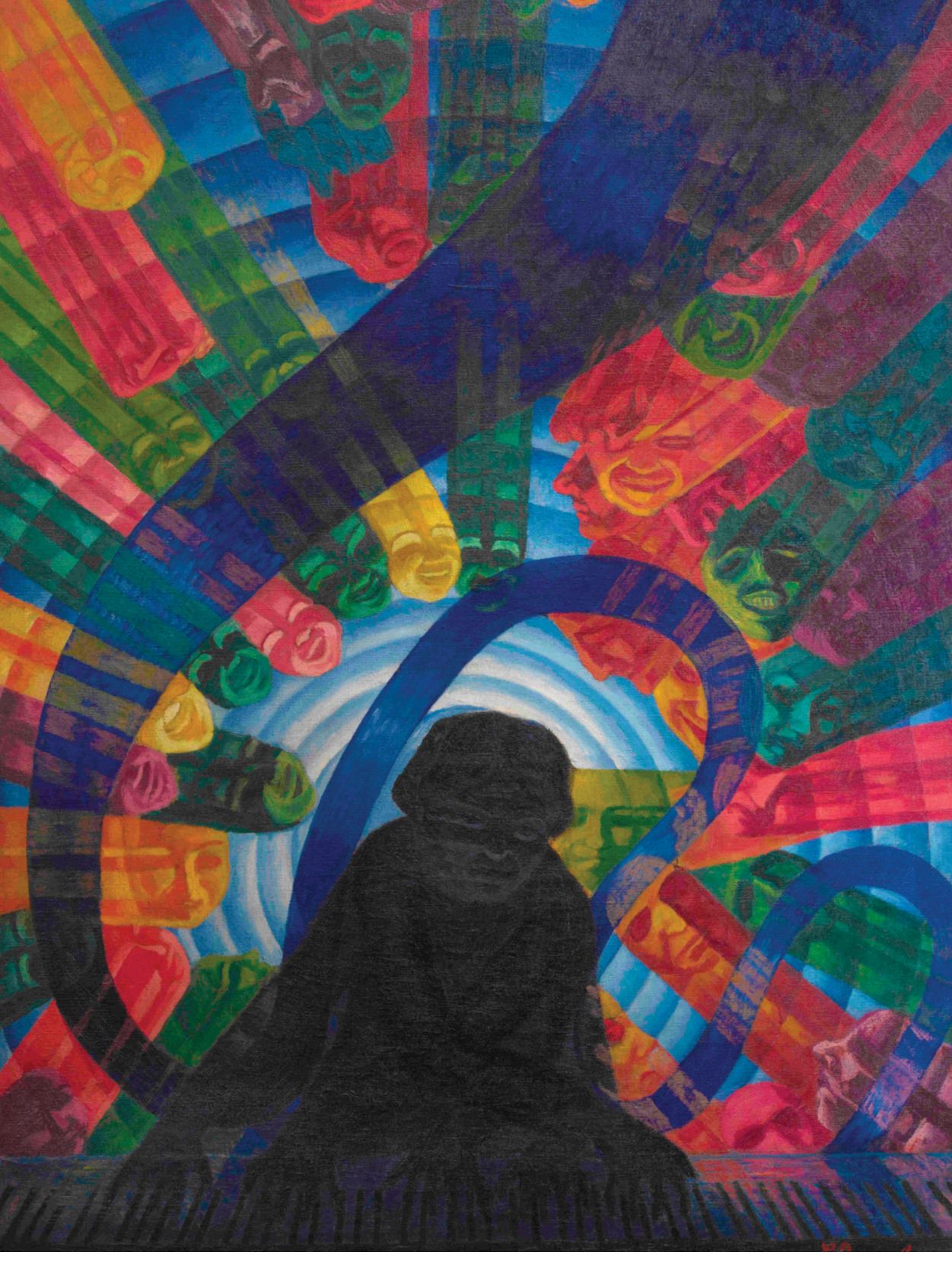
The notion of noise originates from the perception of sound phenomena, which has been used to categorize and distinguish certain sounds from others. Such phenomena may be classified differently across languages. This story draws heavily on episodes from the physics communities in Germany, the UK, and the US. But local and national developments can be understood only in an international context, especially regarding the rapid spread of acoustical knowledge and mass-media technologies. For example, radio and sound film spread across political and cultural boundaries where English became a lingua franca.
The shifts and extensions of noise concepts were accompanied by a fundamental transformation of acoustics research. The science of sound has been closely related to the human sensation and perception of hearing and discourses on speech and music. Consequently, acoustics has never been reduced to physics alone; it resides among several disciplines and between science and culture.
People have complained about noise as a nuisance in urban settings at least since antiquity, according to records from ancient Rome.
1
But physicists turned their attention to noise at a relatively late date. It only became a target of study during World War I. The neglect of noise as a subject of acoustics was related first to researchers’ focus on musical sounds and second to the idealization of music as inherently harmonic—a relationship that scholars have traced back to Pythagoras. For example, in his 1619 book, Harmonices Mundi (The Harmony of the World), Johannes Kepler established a correspondence between the harmony of music and the apparently perfect movement of celestial bodies. (See the article by Aviva Rothman, Physics Today, January 2020, page 36
Ernst Chladni, Hermann von Helmholtz, Lord Rayleigh, and other 19th-century physicists continued to treat acoustics as a science of music and harmony and relegated noise to nonmusical sounds and disharmonic oscillations. For physicists, listening to sound was synonymous to listening to music, and that remained the ruling paradigm in acoustics research until 1914.
Two important developments changed physicists’ engagement with noise: electroacoustics—the application of electricity concepts to acoustics as a research field—and measuring sounds from battlefields in World War I. For the first time, acousticians moved beyond music and became interested in the complex noises of battlefields. War also advanced telephony, wireless, and electric-amplification technologies. In the interwar period, mass media, especially sound motion pictures and radio broadcasting, became the main drivers of acoustics research.
Concepts from electrical engineering were integrated into acoustics research. Scientists and engineers learned that electric oscillations with waveforms identical to acoustic vibrations could be described by using the same mathematical equations and substituting the equivalent electric variables for acoustic ones. Acousticians started using circuit diagrams to represent sound fields, which provided them with a new way to think and talk about sound. 2
Researchers also translated ideas from acoustics into electrical engineering. Originally a parameter of acoustics, the definition of noise was expanded to disturbances in electrical circuits, which limited the intelligibility of communication through telephone and telegraph systems. Using electrical industry research about those systems, Claude Shannon and others introduced signal-to-noise ratios into information theory. 3
The acoustics of Helmholtz and Rayleigh
Two highly influential works on acoustics were published in the second half of the 19th century. One is Helmholtz’s 1863 Die Lehre von den Tonempfindungen als physiologische Grundlage für die Theorie der Musik, published in English in 1875 as On the Sensations of Tone as a Physiological Basis for the Theory of Music. 4 The other is Rayleigh’s The Theory of Sound, 5 published as two volumes in 1877 and 1878. Helmholtz’s and Rayleigh’s respective works laid the foundations for and, until the outbreak of World War I, set the standards and approaches to acoustics research. Helmholtz primarily addressed not physicists but musicologists and aestheticians in an attempt to connect physics, philosophy, and art, which, he argued, had drifted too far apart.
Helmholtz and his contemporaries considered only musical sounds: One would look in vain for the notion of noise as nuisance in his book. The distinction between irregular sounds as noise and harmonic sounds as music was central to his work. In the first chapter of Sensations of Tone, Helmholtz distinguishes noises from musical tones: “The [sounds] of the wind, the splashing of water, the … rumbling of carriages, are examples of the first kind, and the tones of all musical instruments of the second. Noises and musical tones may certainly intermingle …, but their extremes are widely separated” (page 11).
Helmholtz idealizes the sound of musical instruments as “perfectly undisturbed, uniform … which remains unaltered as long as it exists … whereas in a noise many various sensations of musical tone are irregularly mixed up” (page 12). He concludes that the “sensation of a musical tone is due to a rapid periodic motion of the sonorous body; the sensation of a noise to non-periodic motions” (page 13).
Helmholtz merges the physical definition of noise as a nonperiodic motion with an understanding of it as unmusical sounds. After the first chapter, he never returns to discuss noises, though he does point out that musical tones are always accompanied by them. Far from being annoyances, noises from an instrument, such as the scratching or rubbing of a violin bow and the rushing air in a flute or organ pipe, contribute to the instrument’s character and make the music more interesting. Figure
Figure 1.

The vibration microscope was adapted by Hermann von Helmholtz to observe rapid oscillations of violin strings. He examined the various forms of Lissajous patterns (see the inset) that he saw through the microscope for different vibrations of the strings. Irregularities in the patterns (not shown) would have indicated scratching noises from the violin bow or low-quality instruments. (Image from ref.
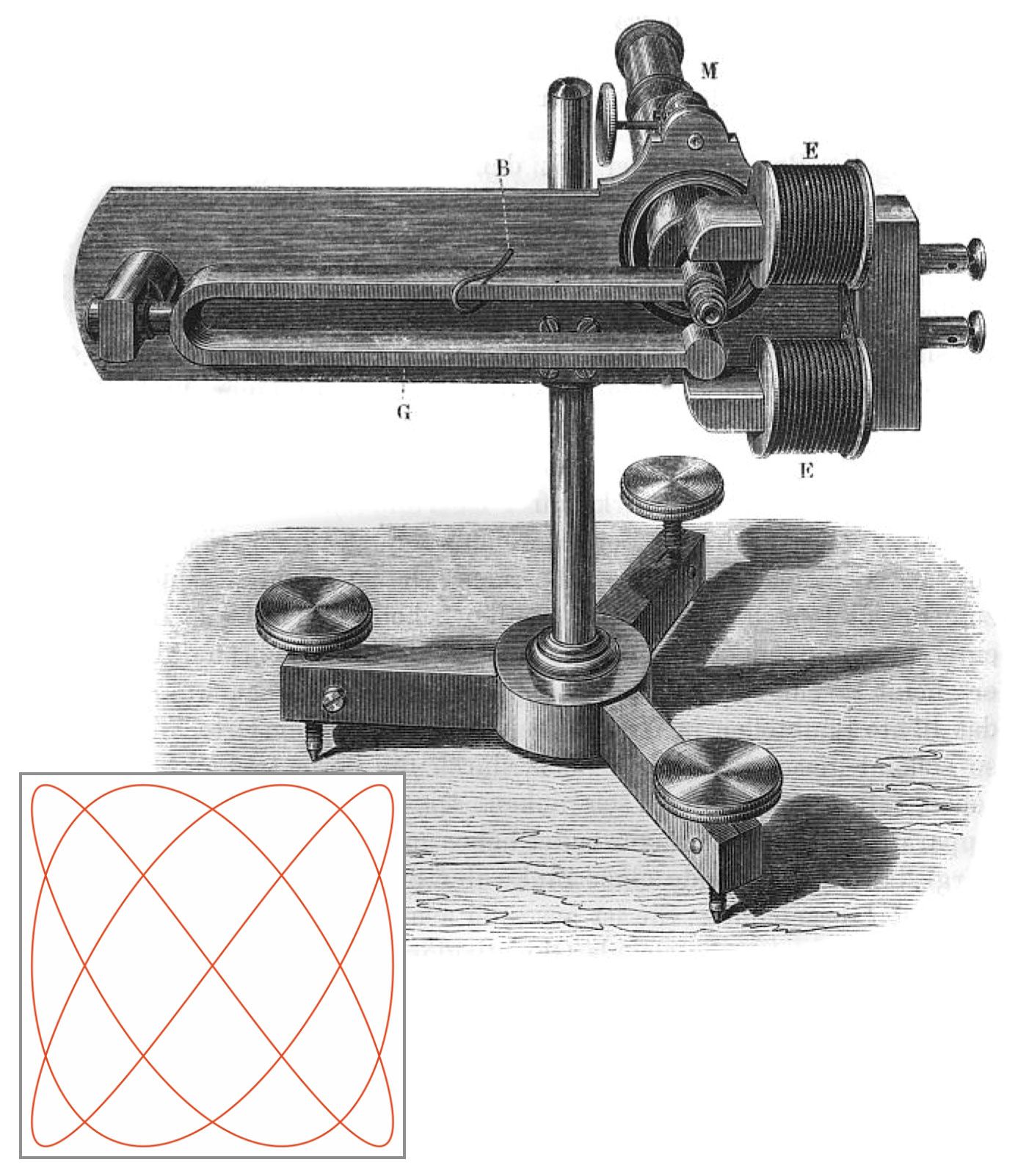
In contrast, Rayleigh considered his audience to be mathematically trained physicists. Nonetheless, he followed Helmholtz’s distinction, and classified sounds “as musical and unmusical; the former for convenience may be called notes and the latter noises. The extreme cases will raise no dispute; everyone recognizes the difference between the note of a pianoforte and the creaking of a shoe…. Although noises are sometimes not entirely unmusical, and notes are usually not quite free from noise, there is no difficulty in recognising which of the two is the simpler phenomenon … no combination of noises could ever blend into a musical note” (volume 1, page 4). After that short passage, Rayleigh also never returns to the topic of noise. His statement that he is providing “the reader a connected exposition of the theory of sound” (volume 1, page v) implies that Rayleigh and his contemporaries only dealt with musical sounds and ignored noise as a topic of scientific concern.
Helmholtz’s and Rayleigh’s treatises continued to set the tone for acoustics research until the outbreak of World War I, but several developments foreshadowed the breakdown of the dichotomy between musical sounds and noises. Helmholtz wanted to place consonance and dissonance—whether listeners find certain sounds pleasant or unpleasant—in the realm of physics and physiology. But one of his strongest critics, philosopher Carl Stumpf, opposed the move. In the following decades, the debate migrated from physics to the emerging disciplines of experimental psychology and comparative musicology. Luigi Russolo, a member of the Italian futurism movement in the early 20th century, wrote a manifesto in 1913 titled L’Arte dei Rumori (The Art of Noises) that constituted a full-fledged attack on the dichotomy between musical sounds and noises.
Whereas the futurists embraced industrial noises and the soundscape of the city, some citizens of metropolises in Europe and North America started to organize noise-abatement societies to battle the din of modern urban living. However, neither the Italian futurists nor the noise-abatement societies managed to turn acousticians’ attention away from musical sounds and toward noise. That happened when physicists were employed in large numbers during World War I to detect the sounds of heavy artillery, aircraft, and submarines.
Sounds of the battlefield
The long list of physicists involved in sound-detection and sound-ranging activities during World War I includes Nobel laureates Max Born, William Henry Bragg, William Lawrence Bragg, Ernest Rutherford, and Erwin Schrödinger. Few of the scientists had worked in acoustics before the war because it had been a rather dormant discipline since the late 19th century. But many did have experience with wireless telegraphy and electrical precision measurements. Rather than study musical sounds in concert halls, the new acousticians had to locate and analyze industrial sounds in the cacophony of the battlefields.
In the beginning, they listened to the sounds of war with funnels or the unaided ear. But those methods were soon found to be unreliable, especially considering a listener’s uneven reaction time for recording sound events from artillery ranging. Scientists worked feverishly to substitute subjective human listeners with so-called objective methods, including microphones, string galvanometers, and mirror oscillographs. But the microphones developed for those methods were not meant to record every sound. For example, the hot-wire microphone invented by William Tucker of the UK was specially designed to record only one signal—the low-frequency firing of heavy artillery—amid all the disturbing noises of the battlefield.
The work of German physicist Erich Waetzmann is in many ways synonymous with the transformation that acoustics underwent during the war. Having first worked in the tradition of Helmholtz, Waetzmann turned toward studying how to locate aircraft noises. He employed instruments like tuning forks and pitch pipes but found that they were inadequate for the task. Emily Mary Smith and Frederic Charles Bartlett of the Cambridge Psychological Laboratory had similar experiences with Politzer acoumeters and soon shifted to using a buzzer circuit and a telephone for training submarine hydrophone operators. 6
Although acousticians did not require sound amplification to locate artillery, they did need radio-tube amplifiers to listen underwater and to detect aircraft. Such technology became available around 1917 to the Entente Powers of France, Britain, and their allies and to the Central Powers—Germany, Austria–Hungary, and their allies. Initially, highly resonant hydrophones were developed for underwater sound signaling to communicate with submarines. But hydrophones could also be used to detect enemy vessels. “U-boat warfare created the need for a second type of [noise] receiver, which was mainly designed to record the noises of ship propellers or alien submarines,” Austrian physicist Franz Aigner explained in his 1922 book Unterwasserschalltechnik (Underwater Sound Technology). The hydrophone can “record equally both the on-board noises of a nearby ship and the working of the ship engine, pumps, electric machines, and the grinding of the propeller. All these noises have a characteristic timbre for the listener, so that with practice he will be able to determine from the noises with absolute certainty the type of ship.”
7
Figure
Figure 2.

A hydrophone operator, aboard a US minelayer in 1918, listens in his headphones to the various sounds recorded by a drifter hydrophone to identify their origins. (Image from the National Maritime Museum archive, London.)
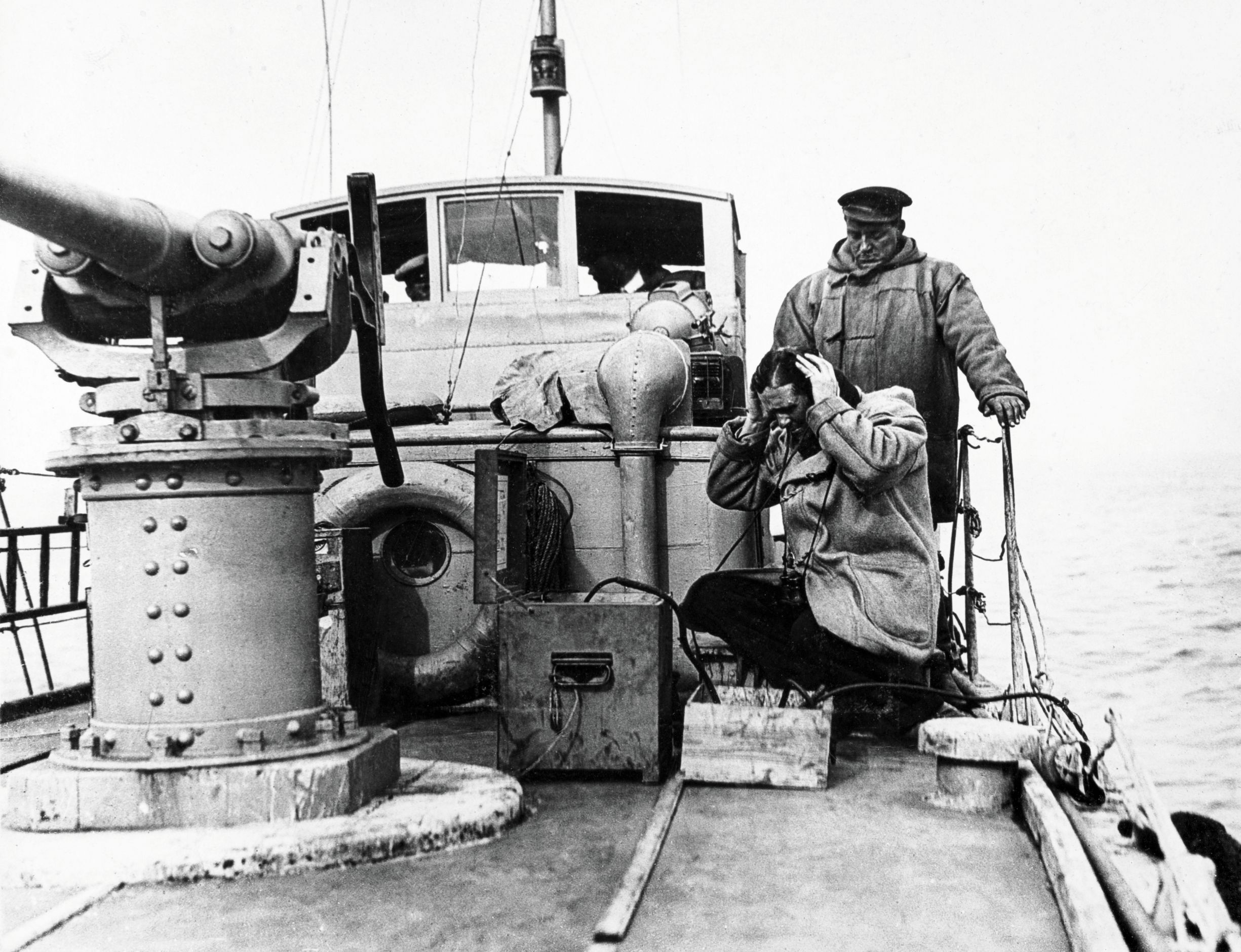
The resonant hydrophone for underwater sound signaling and the nonresonant noise receiver represent notions of signal and noise that were quite different from the dichotomy of musical sounds and nonmusical noises. In Aigner’s account, the noises of the enemy ship were not irksome; rather, they contained highly valuable information about the vessel and its operation. The hydrophone operator had to tune in to the noise.
Even as acousticians realized that they could detect enemy submarines and aircraft by their noise, they also knew that enemy scientists were using the same methods, so they began to silence their machinery. For Waetzmann, studying aircraft sounds was as much about detecting enemy aircraft as it was about eliminating noise to build a “soundless aircraft.” For submarines and aircraft, propellers appeared to be the main source of noise, and the aerodynamic testing laboratory headed by Ludwig Prandtl in Göttingen, Germany, carried out investigations to make them quieter. 6
Warfare finally achieved what the citizen initiatives had not: It turned acousticians’ attention to industrial noise and its abatement. Silencing aircraft wasn’t the result of noise-abatement societies or noise-pollution regulations: It was a military demand.
Interwar electric circuits, noise abatement, and mass media
After the war, military applications were no longer the main driver for acoustics research. Instead of returning to music as the leading paradigm, scientists moved to electroacoustic media and communications technologies, especially radio broadcasting, sound motion pictures, and telephony, as the new framework in which they operated in the 1920s and 1930s. Although the telephone had already been invented in the 19th century, it was mostly seen as an electrical technology and had little effect on acoustics research before the war. The mass employment of scientists in warfare had boosted industrial research, and electrical industry research companies, such as Bell Labs in the US and the Siemens & Halske laboratories in Germany, became the largest employers of physicists and the main actors in acoustics research.
With the advances made to electroacoustic technologies and radio-tube amplifiers during the war, acoustics was transformed from a subfield of mechanics to an electrotechnical discipline. Electroacoustic measurement became the new standard of the field, and acousticians needed proficiency in radio technology rather than in musical listening. That shift was technological and epistemological, as it created a new way of thinking and talking about sound. Terms such as the sound field, antenna, and transmitter were introduced to the acoustic literature. Similarly, acoustic parameters were translated to electric ones, and equivalent circuit diagrams were used to analyze and represent acoustic systems, even if there was nothing electrical about them. For example, Martin Kluge, an electrical engineer in Dresden, Germany, used electric-filter theory to translate the exhaust silencer of an automobile to an electric-circuit diagram, as shown in figure
Figure 3.

This diagram of an automobile exhaust silencer is similar to an electric circuit diagram. Even though the automobile exhaust silencer does not contain any electrical components, diagrams like this one became useful analytical tools for engineers designing an acoustic filter analogous to an electric one.
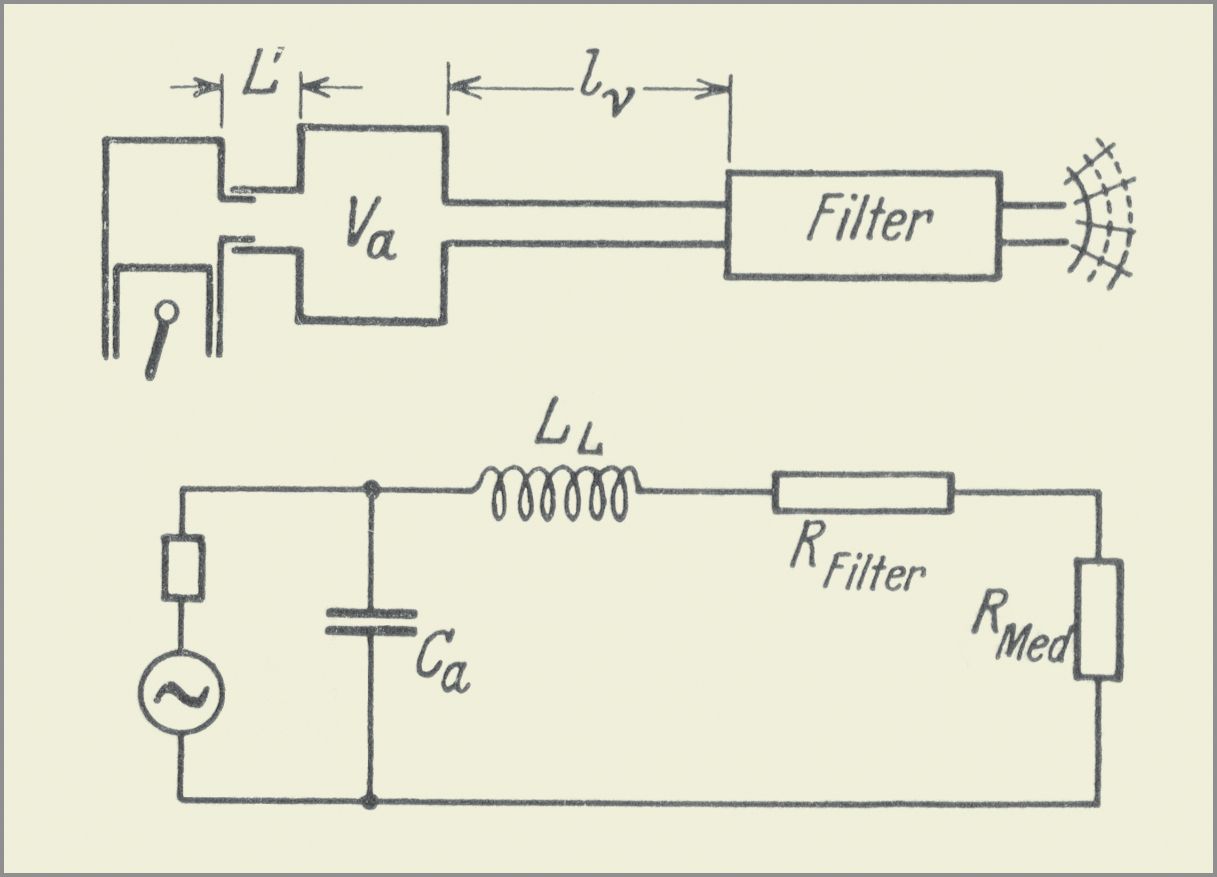
In the context of electroacoustics, noise became a category for random fluctuations and disturbances in electrical systems. Many disturbances originated from a circuit’s components, such as the carbon microphones used at the time. Wireless telegraphy and radio operators dealt with static interference, the atmospheric disturbances of radio waves. Radio-tube amplifiers could strengthen weak acoustic signals until they were drowned out by noise created in the amplifier circuit itself.
The crucial device for advancing electroacoustics was the amplifier tube. Theoretical physicist Walter Schottky had worked on it at the Siemens & Halske labs during the war. His innovation of screen-grid vacuum tubes in 1915–16 improved their performance considerably, and in 1918 he published a groundbreaking paper in which he identified the lower limit of thermal disturbances in amplifier tubes. 8 At the time, listening to those disturbances from a telephone or loudspeaker was the only way to detect them. That made Schottky’s choice of acoustic terminology for describing the electric disturbance—buzzing—a natural one; his lab colleague Carl Hartmann labeled it a shot-effect tone in 1922. Later, in 1925, John Bertrand Johnson of Bell Labs finally called it a noise. 9
Importantly, the discovery and categorization of shot noise shifted the semantic and conceptual idea of noise and introduced it as one of random thermal fluctuations and as a parameter of electrical systems. How did noise as an aperiodic fluctuation relate to noise as a nuisance? In the late 1920s and 1930s, acousticians and public institutions started to participate in the noise-abatement campaigns of metropolitan cities such as New York, London, and Berlin. Figure
Figure 4.

This advertisement for the Anti-Noise League in London highlights the noise-abatement concerns of some citizens during the 1920s and 1930s. During that time, acousticians started to systematically study the noise environment in European and US cities. (Image from the Noise Abatement exhibition, Science Museum, London, 1935.)
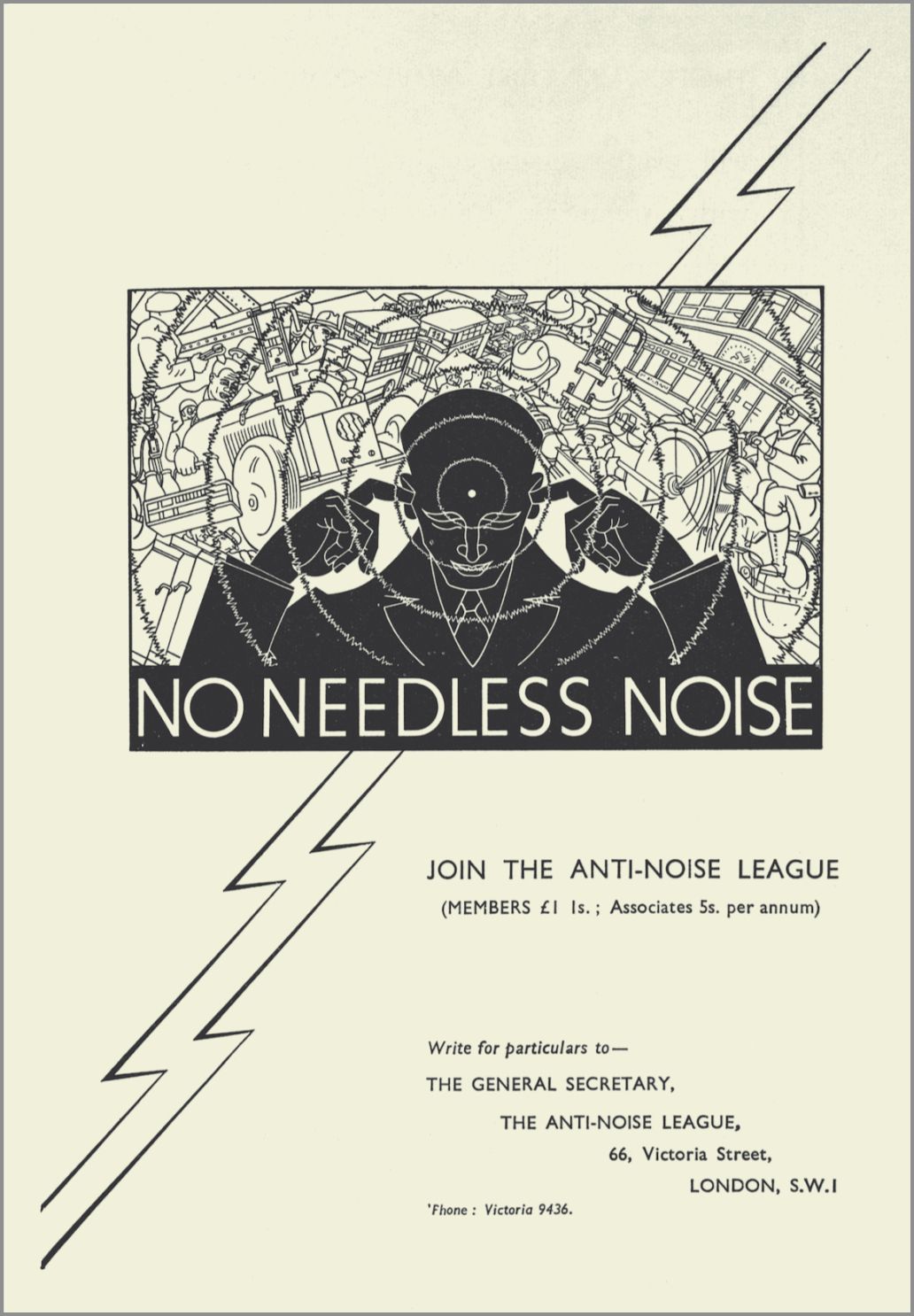
Bartlett’s German-speaking colleagues would point out that noise as a nuisance, Lärm, should not be confused with noise as a nonperiodic sound, Geräusch. The German commission for units and formulae drafted instructions in 1933 detailing how to demarcate the two. According to the instructions, noise as a nonperiodic sound was a purely objective, physical value, and its measurement should be straightforward, at least in principle. In contrast, noise as a nuisance was an inherently subjective value and could only be measured indirectly. 11
Did demarcating noise as either an entirely objective or inherently subjective concept work in practice? Harvey Fletcher, the collaborator to Robert Millikan in the famous oil-drop experiment, became in 1928 Bell Labs’ leading acoustician. In his 1929 book Speech and Hearing, Fletcher wrote that “when transmitting speech or music … over … a radio or a telephone system, there is always an interference to the proper reception of such speech and music, due to other sounds being present. These extraneous sounds which serve only to interfere with the proper reception are designated by engineers as ‘noise.’ With such a designation, the sound may be either periodic or non-periodic as long as it is something that would be better eliminated.” 12
Fletcher’s account reveals that a clear-cut definition of noise as a nonperiodic fluctuation was not practical for the electrical-communication engineers at Bell Labs. Ferdinand Trendelenburg, then the chief acoustician of Siemens central research lab, also found it difficult to clearly separate harmonic sounds from noises. In his 1935 book Klä̈nge und Geräusche (Sounds and Noises), he found that “the compound tone of a piano, for example, is not strictly periodic, in the moment of strike [of the piano string], the compound tone is mixed with the noise of the hammer …; nevertheless, in linguistic usage we would always call the sound of the piano a compound tone, for the ear in this case the tone-like characteristic is the preeminent characteristic.” 13
A universal concept
The history of noise underlines the relevance of acoustics in the evolution of modern physics during the 20th century.
6
Rayleigh’s Theory of Sound was an important resource for the development of Maxwellian electrodynamics and, to a lesser extent, of quantum mechanics and the theory of relativity (see the article by Carlo Beenakker and Christian Schönenberger, Physics Today, May 2003, page 37
By the 1950s, the definition of noise as random or unwanted fluctuations in all kinds of physical systems had been firmly established, and its acoustic origins had become almost invisible. Since then, noise has experienced a transition to a digital-information paradigm that is closely related to data transmission over telephone lines and early computers. 14 Although definitions have moved from music to information, researchers continue to operate with notions of noise that lie somewhere between random fluctuations without a pitch and unwanted sounds or data, whether harmonic or not.
Today concepts of noise are used in a broad range of scientific fields, including statistical mechanics, applied mathematics, quantum electronics, computer science, and even the humanities and social sciences. 15 I hesitate to question the relevance of categories like applied and pure science or classical and modern physics, but the history of noise exemplifies how fluid and porous such categories are, how they transform, and where they might break down. Although scientists have created more refined categories of noise, one person’s noise may be someone else’s signal. As the hydrophone operators of World War I did, one must tune in to the noise to extract information from it. Far from noise becoming more objective, it remains deeply entangled with the focus of an investigation and the goals of the researchers.
References
1. K. Bijsterveld, Mechanical Sound: Technology, Culture, and Public Problems of Noise in the Twentieth Century, MIT Press (2008).
2. R. Wittje, Osiris 28, 40 (2013). https://doi.org/10.1086/671362
3. C. E. Shannon, W. Weaver, The Mathematical Theory of Communication, U. Illinois Press (1949).
4. H. L. F. Helmholtz, On the Sensations of Tone as a Physiological Basis for the Theory of Music, A. J. Ellis, trans., Longmans, Green (1875).
5. J. W. Strutt (Lord Rayleigh), The Theory of Sound, 2 vols., Macmillan (1877–78).
6. R. Wittje, The Age of Electroacoustics: Transforming Science and Sound, MIT Press (2016).
7. F. Aigner, Unterwasserschalltechnik: Grundlagen Ziele und Grenzen—Submarine Akustik in Theorie und Praxis (Underwater Sound Technology: Basics, Goals, and Limits—Submarine Acoustics in Theory and Practice), Krayn (1922), p. 203; R. Wittje, trans.
8. W. Schottky, Ann. Phys. 362, 541 (1918). https://doi.org/10.1002/andp.19183622304
9. R. Wittje, Perspect. Sci. 24, 7 (2016). https://doi.org/10.1162/POSC_a_00189
10. F. C. Bartlett, The Problem of Noise, Cambridge U. Press (1934), p. 3.
11. K. W. Wagner, Forsch. Fortschr. 12, 12 (1936).
12. H. Fletcher, Speech and Hearing, D. Van Nostrand (1929), p. 99.
13. F. Trendelenburg, Klänge und Geräusche: Methoden und Ergebnisse der Klangforschung . . . (Sounds and Noises: Methods and Results of Sound Research . . .), Springer (1935), p. 19; R. Wittje, trans.
14. S. M. Bullock, Perspect. Sci. 24, 73 (2016). https://doi.org/10.1162/POSC_a_00192
15. C.-P. Yeang, J. L. Bromberg, Perspect. Sci. 24, 1 (2016). https://doi.org/10.1162/POSC_e_00188
16. F. Trendelenburg, Fortschritte der physikalischen und technischen Akustik (The Advances of Physical and Technical Acoustics), Akademische Verlagsgesellschaft (1934).
More about the Authors
Roland Wittje is an associate professor in the history of science and technology at the Indian Institute of Technology Madras in Chennai.
